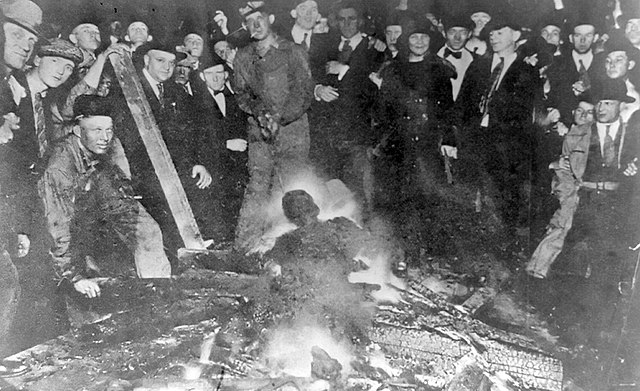Racial tension in Omaha, Nebraska
Racial tension in Omaha, Nebraska occurred mostly because of the city's volatile mixture of high numbers of new immigrants from southern and eastern Europe and African-American migrants from the Deep South. While racial discrimination existed at several levels, the violent outbreaks were within working classes. Irish Americans, the largest and earliest immigrant group in the 19th century, established the first neighborhoods in South Omaha. All were attracted by new industrial jobs, and most were from rural areas. There was competition among ethnic Irish, newer European immigrants, and African-American migrants from the South, for industrial jobs and housing. They all had difficulty adjusting to industrial demands, which were unmitigated by organized labor in the early years. Some of the early labor organizing resulted in increasing tensions between groups, as later arrivals to the city were used as strikebreakers.
In Omaha as in other major cities, racial tension has erupted at times of social and economic strife, often taking the form of mob violence as different groups tried to assert power. Much of the early violence came out of labor struggles in early 20th century industries: between working class ethnic whites and immigrants, and blacks of the Great Migration. Meatpacking companies had used the latter for strikebreakers in 1917 as workers were trying to organize. As veterans returned from World War I, both groups competed for jobs. By the late 1930s, however, interracial teams worked together to organize the meatpacking industry under the United Packinghouse Workers of America (UPWA). Unlike the AFL and some other industrial unions in the CIO, UPWA was progressive. It used its power to help end segregation in restaurants and stores in Omaha, and supported the civil rights movement in the 1960s. Women labor organizers such as Tillie Olsen and Rowena Moore were active in the meatpacking industry in the 1930s and 1940s, respectively.

Dr. Martin Luther King Jr. Cornerstone Memorial at the NW corner of 24th & Lake St in North Omaha.
The Omaha Race Riot occurred in Omaha, Nebraska, September 28–29, 1919. The race riot resulted in the lynching of Will Brown, a black civilian; the death of two white rioters; the injuries of many Omaha Police Department officers and civilians, including the attempted hanging of Mayor Edward Parsons Smith; and a public rampage by thousands of white rioters who set fire to the Douglas County Courthouse in downtown Omaha. It followed more than 20 race riots that occurred in major industrial cities and certain rural areas of the United States during the Red Summer of 1919.
Photograph taken showing the body of Will Brown after being burned by a white lynch mob.
Rioters on the south side of the Douglas County Courthouse in Omaha.
Riots break windows broken out, people climbing the Douglas County Courthouse.
The sight of Will Brown lynched, with his body mutilated and burned by a white crowd.





